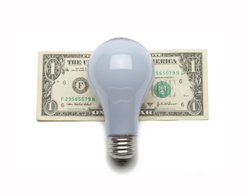
Our Pledge To The Environment
Each of us here at Reach To Teach firmly believe that we have a moral obligation to do what we can to preserve the environment, which includes our adopted homes here in Taiwan, Korea and China. We would like to use this space to encourage our applicants, regardless of where and if you decided to go, to make an extra effort to conserve energy and reduce our negative imprint on the world.
To this end we have put together these 10 easy ways you can help the environment right now!
 Help save the planet and save yourself some money doing it!
Help save the planet and save yourself some money doing it!
10. Switch Out Your Lighting
CFLs (compact fluorescent light bulbs) are well known for substantial energy savings (they use about 75% less energy than standard incandescent), plus they last much longer. Over the course of a year this can add up to a significant energy savings and lower electric bills!
9. Turn Off Lights
Your dear old Dad wasn't just being stingy back when he fussed at you for leaving lights on after you left the room. Lighting is responsible for about 11 percent of a home's energy bills. By turning off lights you don't need, you'll begin to see savings right away, and will extend the lifetime of all those bulbs you just replaced.
8. Unplug Unused Chargers and Appliances
Even when you aren't charging your cell phone, laptop or other appliances, they continue to draw electricity. In fact we throw away about 8% of our annual electric bills this way, adding up to a tremendous waste of energy and money.
The solution is simple: just unplug them or use a surge protector and flip that switch when your device has pulled enough juice.
 Our planet is worth preserving
Our planet is worth preserving
7. Wash Your Laundry in Cold Water
An easy way to clean green is to turn the dial on your washing machine to cold. Most loads don't need hot water, and 90% of the energy used by washing machines goes into heating. The higher the water temperature, the higher the cost to you and the planet.
6. Water Smarts
Drink water from the tap instead of buying single-use bottled water, which requires much more energy to produce, store and transport. Barely 20% of those plastic bottles end up getting recycled, and most are made out of petroleum. Use filters if you are concerned about your local water supply.
Buy a reusable bottle to take with you on the go. These are easy to refill from a tap and thereby avoiding bottled water. Stainless steel is a good choice because you don't have to worry about the potentially toxic chemicals that can leach out of many plastics over time.
5. Bag It
When you go out shopping bring your own reusable bags. This preserves resources by cutting down on the huge number of paper and plastic bags that are discarded after a single trip. While your at it cut back on your use of plastic utensils and paper napkins. A great tip here in Asia is to bring your own chopsticks whenever you eat out thereby cutting back on the huge number of bamboo chopsticks that are discarded after only a single use.
 Reusable shopping bags are cheap and can quickly save hundreds of plastic bags from ever entering a landfill
Reusable shopping bags are cheap and can quickly save hundreds of plastic bags from ever entering a landfill
4. Install Low-Flow Water Fixtures
Decades ago, toilets used 5 gallons per flush, but these days more efficient models are readily available. Low-flow models use less than a gallon, and work great.
Save even more water and money with a low-flow showerhead, which can slash bathing-water consumption 50 to 70 percent. The devices are simple to install and start at around $8. Low-flow faucets are also a great option.
3. Travel Light
When and where ever you travel, plan carefully and take what you know you will really need. Reducing the amount of baggage we take with us seriously reduces the amount of energy it takes to get us there. If every traveler reduced their travel load by 10 pounds the combined gas savings would equal 350 millions gallons over the course of a year.
2. Recycle!
We are not just talking about the simple stuff, newspapers and plastic bottles, but everything in our daily lives. Old cell phones and other electronic equipment can easily be recycled and put to good use. Donate your old clothing to goodwill services. Anything that does not end up in a landfill is helping our environment.
 Public transpiration, such as subways, are a great way to save money and avoid the congestion of city traffic
Public transpiration, such as subways, are a great way to save money and avoid the congestion of city traffic
1. Take Public Transportation
By one estimate, the public transportation system in the United States saves 3.4 billion gallons of oil a year (and cuts greenhouse gas emissions by 26 million tons). Get your fair share of the savings by looking up the local bus route or climbing on the subway.
Even better, walk or bike to work or school whenever possible. Every mile you pedal or stride saves you gas, saves you money and puts you in better shape. If you trade in a trip in the average car, you'd save about $1 for every 5 miles you walk or pedal. (Use the money to buy a new umbrella for rainy days, or put it into a savings for a rainy day shopping spree.)
These are just a few of the ways that each one of us can do to save energy and do our part to preserve the environment for future generations. For more information to find out more ways to help, explore each one of these links.
Thanks!
The Reach To Teach Team


